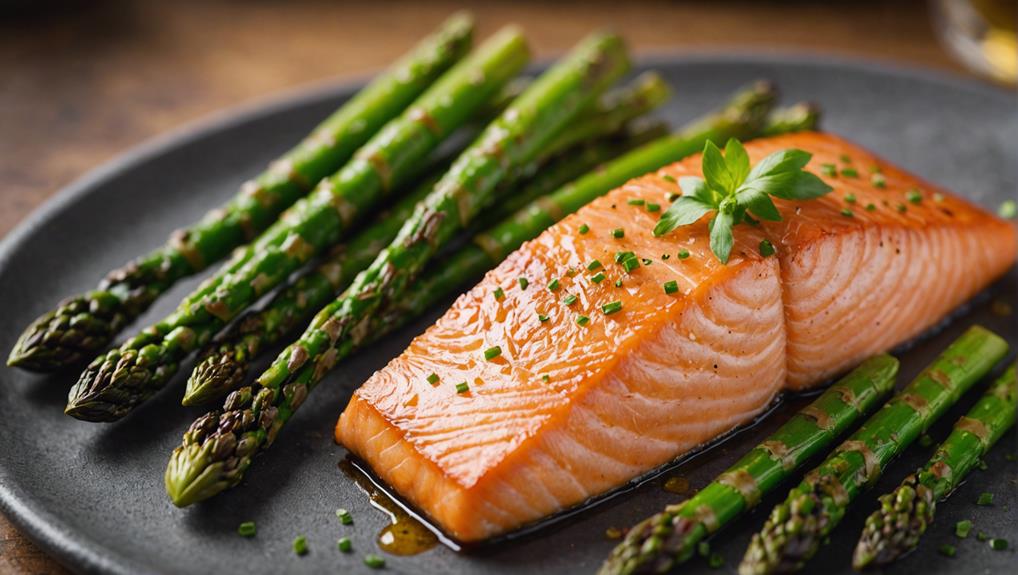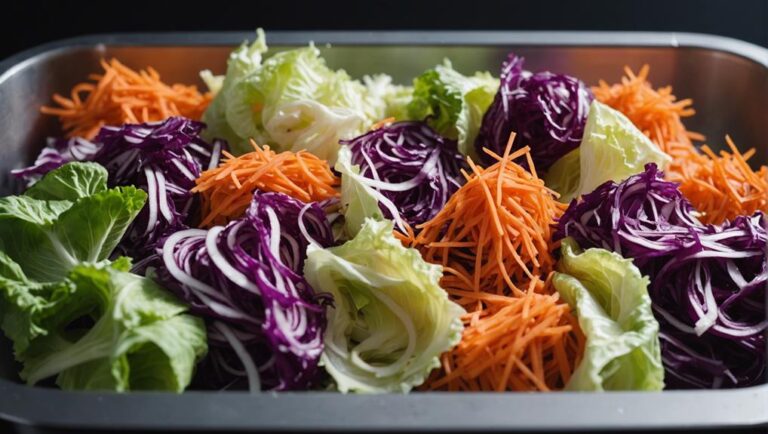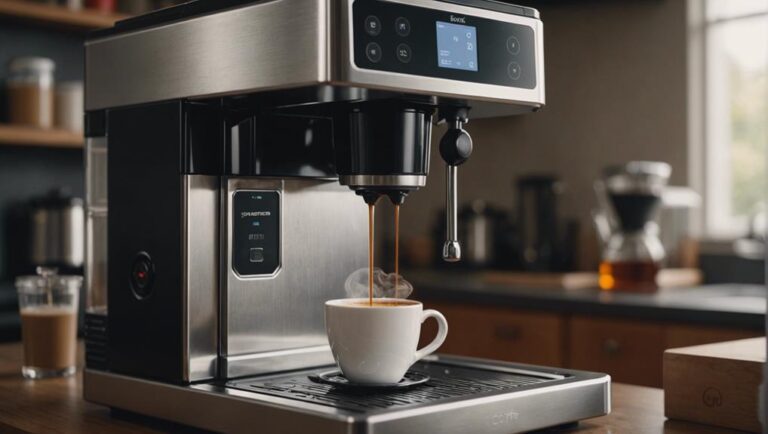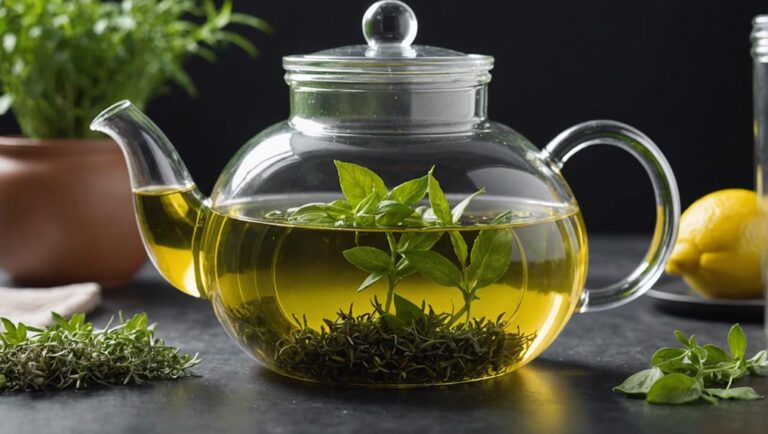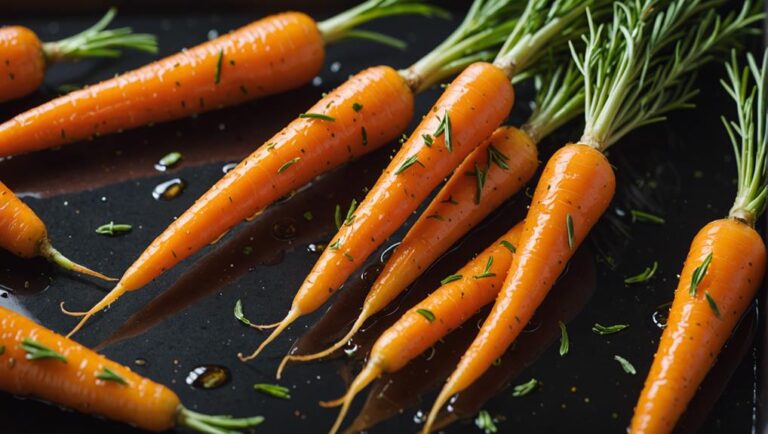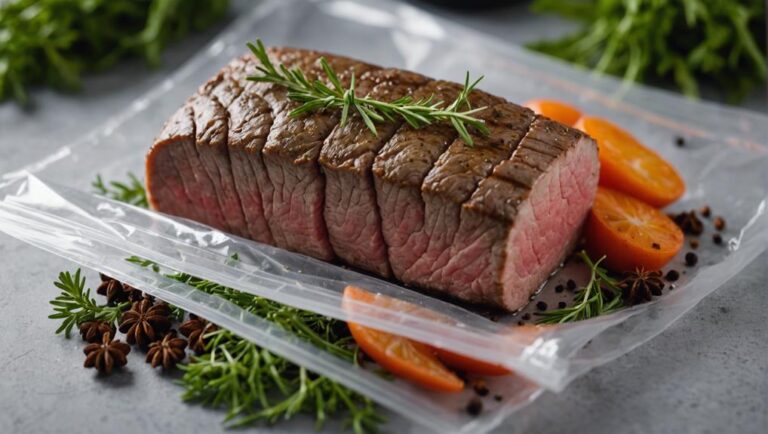Sous Vide Salmon With Asparagus
Immerse your taste buds in a luxurious feast by preparing sous vide salmon alongside crisp asparagus for a dining experience that radiates elegance. The delicate salmon is marinated with a blend of soy sauce, honey, garlic, and ginger, enhancing its natural flavors. Explore variations like Dill-Crusted, Lemon-Herb Infused, or Savory Maple Glazed Salmon for a burst of unique tastes. Achieve the perfect texture and flavor by searing the salmon to add a crispy finish. As the savory salmon melts in your mouth, the asparagus provides a delightful crunch. Elevate your culinary skills and explore a world of sophisticated flavors.
What You Will Learn Here
- Sous vide cooking ensures precise temperature control for perfectly cooked salmon.
- Marinate salmon with soy sauce, honey, garlic, and ginger for enhanced flavor.
- Sear salmon after sous vide for a crispy skin and added depth of flavor.
- Asparagus should be blanched for a satisfying crunch and tenderness.
- Combine sous vide salmon and asparagus for a harmonious blend of flavors and textures.
Sous Vide Origins
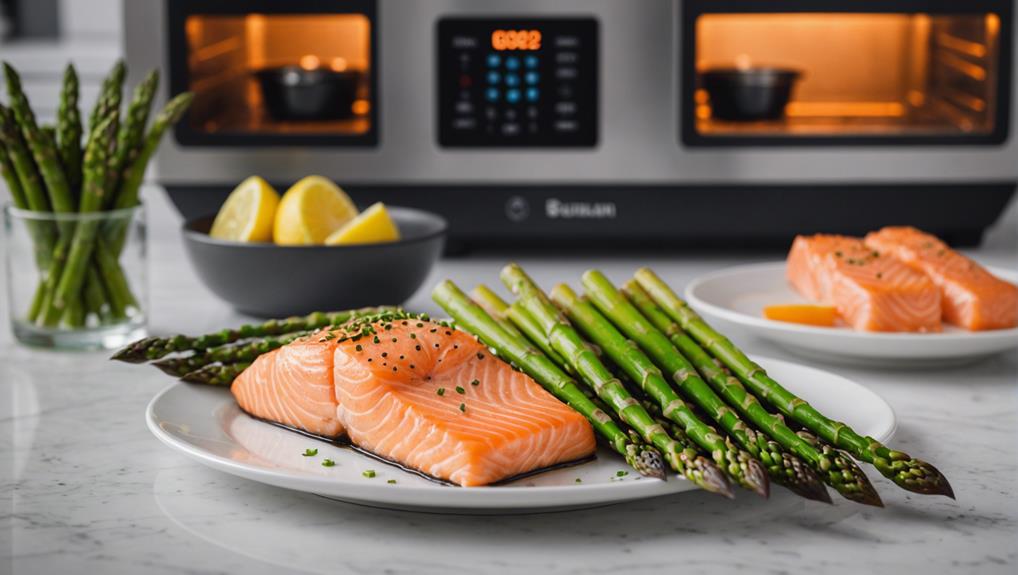
Sous vide is a cooking method that originated in the 1970s. It revolutionized the culinary world by introducing precise temperature control for cooking food in vacuum-sealed bags. This modern technique has its roots in the French term meaning 'under vacuum,' highlighting the importance of sealing ingredients to maintain flavors and textures.
Sous vide's innovative origins have influenced contemporary cooking practices, elevating the precision and consistency of dishes in professional kitchens and home cooking alike.
Sous Vide History
With origins dating back to the late 18th century, the cooking method known as sous vide has evolved into a precise and popular culinary technique today. Sous vide techniques have transformed from traditional methods of cooking food in vacuum-sealed bags submerged in water baths to the modern applications that allow for precise temperature control and consistency in cooking. This evolution in sous vide history has revolutionized the way chefs approach cooking, ensuring that dishes are cooked to perfection every time. The table below highlights the historical evolution of sous vide techniques from their traditional roots to their modern applications:
| Historical Evolution | Modern Applications |
|---|---|
| Slow cooking in jars | Precise temperature control |
| Vacuum sealing for preservation | Consistency in cooking |
| Limited to professional kitchens | Home sous vide machines available |
| Emphasis on food safety | Enhanced flavors and textures |
| Sous vide for preserving food | Creativity in recipe development |
Modern Cooking Technique
The evolution of modern cooking techniques has seen the emergence of sous vide as a precise and innovative method that guarantees consistent results in the culinary world. Precision cooking is at the core of sous vide, where ingredients are vacuum-sealed in bags and cooked in a water bath at a precisely controlled temperature. This method allows for flavor infusion, ensuring that the food retains its natural taste and juices.
One of the key advantages of sous vide is the time-saving aspect it offers. By cooking food slowly over an extended period, the results are consistently delicious, tender, and perfectly cooked. This technique has revolutionized the way chefs approach cooking, providing a level of control and quality that was previously unmatched.
Culinary Innovation Origins
Originating from the French culinary scene, the innovative cooking technique of sous vide has steadily gained recognition worldwide for its precision and consistency in delivering mouthwatering dishes. Culinary evolution and experimentation have pushed chefs to explore new ways of preparing food, leading to the rise of sous vide cooking. This method involves sealing ingredients in airtight bags and cooking them in a water bath at precise temperatures, ensuring perfect doneness and enhanced flavors. Chefs have been able to play with unique ingredient combinations and flavor profiles, creating dishes that were once unimaginable. The controlled environment of sous vide allows for a level of consistency that traditional cooking methods sometimes struggle to achieve.
| Culinary Evolution | Experimentation |
|---|---|
| Precision cooking techniques | Pushing boundaries with new flavors |
| Consistent results | Creative ingredient combinations |
| Rise of innovative methods | Exploring unique flavor profiles |
Salmon Marinade Ingredients

What essential ingredients do you need to create a flavorful marinade for the salmon in this recipe? When it comes to elevating the taste of your salmon, the marinade plays an important role. Here are some key ingredients that will help you achieve a delicious flavor profile for your sous vide salmon:
- Soy Sauce: Adds a savory umami richness to the salmon.
- Honey: Provides a touch of sweetness to balance out the flavors.
- Garlic: Infuses the salmon with a fragrant and aromatic taste.
- Ginger: Adds a subtle heat and depth of flavor to the marinade.
These ingredients work together to create a harmonious blend of flavors that will enhance the natural taste of the salmon. Feel free to adjust the quantities to suit your personal preferences, whether you prefer a more intense marinade or a lighter touch. Experimentation is key when it comes to creating the perfect marinade for your salmon.
Tasty Salmon Variations
Explore a world of flavor with these tantalizing salmon variations:
- The Delicious Dill-Crusted Salmon offers a crunchy herb-infused crust.
- The Lemon-Herb Infused Salmon bursts with zesty freshness.
- The Savory Maple Glazed Salmon provides a sweet and savory balance.
Each recipe brings a unique twist to the classic salmon dish, promising a delightful culinary experience that will satisfy your taste buds and impress your guests.
Enjoy experimenting with these different flavors to discover your favorite way to elevate this versatile fish.
Delicious Dill-Crusted Salmon Recipe
To elevate your salmon dish to a new level of flavor and texture, consider trying out this delectable dill-crusted salmon recipe. The combination of the herbaceous dill seasoning with the succulent salmon creates a harmonious blend that will tantalize your taste buds.
Here are some reasons why this recipe is a must-try:
- The dill crust adds a crispy texture that perfectly complements the tender salmon.
- It brings a burst of freshness to each bite, enhancing the overall dining experience.
- The aromatic flavors of the dill infuse into the salmon, creating a symphony of tastes with every mouthful.
- Paired with a side of roasted asparagus, this dish becomes a well-rounded meal that satisfies both your cravings and your nutritional needs.
Lemon-Herb Infused Salmon
Consider infusing your salmon with the zesty flavors of lemon and fragrant herbs for a revitalizing twist on this classic dish. When using sous vide techniques, the salmon becomes incredibly tender, allowing the lemon and herb infusion to penetrate every succulent bite.
Here's why this lemon-herb infused salmon will elevate your dining experience:
- Freshness: The burst of citrus from the lemon combined with the earthy aroma of the herbs creates an invigorating sensation.
- Vibrancy: The bright colors and aromatic scents will awaken your senses, making each bite a delightful experience.
- Balance: The subtle blend of tangy lemon and savory herbs perfectly complements the rich flavors of the salmon.
- Elegance: The delicate infusion enhances the presentation of the salmon, making it a visually appealing dish.
Enjoy the freedom to savor this exquisite lemon-herb infused salmon, a true culinary masterpiece.
Savory Maple Glazed Salmon
Elevate your salmon game with the tantalizing flavors of a savory maple glaze that adds a perfect balance of sweetness and depth to your dish. Imagine the succulent salmon fillet, perfectly cooked and glistening with a sweet glaze that caramelizes to perfection. The aroma alone will have your taste buds dancing in anticipation.
Unleash a burst of flavor with each bite, as the sweet glaze melds seamlessly with the tender salmon, creating a symphony of taste. The flavorful seasoning enhances the natural richness of the fish, elevating it to new heights. Your palate will thank you for this delightful culinary experience.
- Indulge in the harmonious blend of sweet and savory notes.
- Treat yourself to a luxurious dining experience without leaving your home.
- Delight in the richness of the maple glaze as it coats each flaky bite.
- Savor every mouthful and let the flavors transport you to a world of culinary bliss.
Salmon Searing Technique
When searing salmon, you'll focus on enhancing flavor by creating a caramelized crust.
Temperature control is essential to guarantee the fish cooks perfectly while maintaining its moisture.
Achieving crispy skin adds a delightful contrast in texture to the tender flesh.
Searing for Flavor
For a perfectly seared salmon that enhances its natural flavors, make sure your pan is hot and well-oiled before adding the fish. Achieving a flavorful sear on your salmon is essential for a delightful culinary experience. Here are some searing tips to help you master this technique:
| Searing Tips | Description |
|---|---|
| Preheat Your Pan | Make sure your pan is hot before adding the salmon. |
| Oil the Pan | Use a high smoke point oil like grapeseed or avocado oil. |
| Pat Dry the Salmon | Moisture impedes the searing process, so dry the fish well. |
| Avoid Overcrowding | Sear the salmon in batches to prevent steaming. |
Temperature Control Importance
Maintaining precise temperature control while searing salmon is essential to achieving the perfect balance of a crispy exterior and a moist, tender interior. The temperature precision during the searing process determines the cooking results, ensuring that the salmon's texture remains succulent and flavorful.
When searing sous vide salmon, the right temperature not only develops a beautifully caramelized crust but also retains the delicate flavors locked in during the sous vide cooking. It's vital to monitor the heat diligently to prevent overcooking and maintain the desired level of doneness.
Achieving Crispy Skin
To achieve a perfectly crispy skin on your sous vide salmon, guarantee the searing process is executed with precise timing and high heat. The key to achieving that delightful crispy texture while maintaining flavor balance is to make sure your pan is scorching hot before adding the salmon.
Pat the salmon skin dry, season it generously, and gently lay it skin-side down in the hot pan. Allow it to sear undisturbed for about 2-3 minutes until the skin is golden and crisp. Be attentive and resist the temptation to flip too soon. Experiment with different cooking methods like using a cast-iron skillet or a blowtorch for varying textures.
Final Thoughts
In wrapping up your experience with this delicious sous vide salmon and asparagus dish, consider the harmonious blend of flavors and textures that have been expertly enhanced through the precise cooking method.
The flavor profile of the salmon is delicate yet rich, with a hint of citrus and herbaceous notes that complement the natural taste of the fish. The asparagus, cooked to perfection using the sous vide method, maintains a satisfying crunch while still being tender and flavorful.
When it comes to texture preference, the sous vide cooking method guarantees that both the salmon and asparagus are incredibly moist and succulent. The salmon flakes apart beautifully with a fork, showcasing its perfectly cooked flesh. The asparagus retains its vibrant green color and firmness, adding a lovely crunch to each bite.
As for plating presentation, the elegant simplicity of laying the salmon fillet atop a bed of asparagus spears creates a visually appealing dish that's as delightful to look at as it's to eat. The vibrant colors and textures make for a feast for both the eyes and the taste buds, making this sous vide salmon and asparagus dish a true culinary delight.
Frequently Asked Questions
Can I Use Frozen Salmon for Sous Vide Cooking?
Yes, you can use frozen salmon for sous vide cooking. However, thaw it first for better texture and quality. Adjust cooking times slightly as frozen salmon may take a bit longer. Enjoy your flavorful and tender salmon!
How Long Can I Store Sous Vide Salmon Leftovers?
To guarantee the safety of your leftover sous vide salmon, proper storage is essential. Refrigerate promptly, placing the salmon in an airtight container. Consume within 3-4 days. Always reheat thoroughly to an internal temperature of 165°F for leftover safety.
Is It Safe to Reuse Sous Vide Marinade?
When reusing sous vide marinade, make sure it's safe by boiling it for at least 5 minutes to kill any harmful bacteria. This process also helps retain flavors. Prioritize food safety to enjoy delicious dishes.
Can I Substitute Asparagus With Other Vegetables?
You can substitute asparagus with a variety of vegetables like green beans, zucchini, or broccoli. Experiment with different textures and flavors. Consider adjusting cooking techniques to suit each vegetable. Sous vide benefits by maintaining nutrients and enhancing taste profiles.
Should I Pat Dry Salmon Before Searing?
Before searing salmon, always pat it dry for a crispy crust. Proper searing techniques involve a hot pan, butter, and seasoning. Marinades enhance flavor but can inhibit searing. Experiment with different methods for the best results.
Conclusion
Indulge in the perfectly cooked sous vide salmon with tender asparagus for a meal that's sure to impress.
The marinade infuses the fish with bold flavor, while the searing technique adds a crispy finish.
With various tasty variations to choose from, this dish is versatile and delicious.
Elevate your culinary skills with this simple yet elegant recipe that will have you coming back for more.
Bon appétit!
